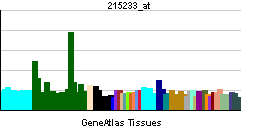JMJD6
| Jumonji domain containing 6 | |||||||||||
|---|---|---|---|---|---|---|---|---|---|---|---|
| Identifiers | |||||||||||
| Symbols | JMJD6 ; KIAA0585; PSR; PTDSR; PTDSR1 | ||||||||||
| External IDs | Template:OMIM5 Template:MGI HomoloGene: 9046 | ||||||||||
| |||||||||||
| RNA expression pattern | |||||||||||
 | |||||||||||
 | |||||||||||
| More reference expression data | |||||||||||
| Orthologs | |||||||||||
| Template:GNF Ortholog box | |||||||||||
| Species | Human | Mouse | |||||||||
| Entrez | n/a | n/a | |||||||||
| Ensembl | n/a | n/a | |||||||||
| UniProt | n/a | n/a | |||||||||
| RefSeq (mRNA) | n/a | n/a | |||||||||
| RefSeq (protein) | n/a | n/a | |||||||||
| Location (UCSC) | n/a | n/a | |||||||||
| PubMed search | n/a | n/a | |||||||||
Jumonji domain containing 6, also known as JMJD6, is a human gene.[1]
This gene encodes a nuclear protein with a JmjC domain. JmjC domain-containing proteins are predicted to function as protein hydroxylases or histone demethylases. This protein was first identified as a putative phosphatidylserine receptor involved in phagocytosis of apoptotic cells; however, subsequent studies have suggested that the protein may cross-react with a monoclonal antibody that recognizes the phosphatidylserine receptor and does not directly function in the clearance of apoptotic cells. Multiple transcript variants encoding different isoforms have been found for this gene.[1]
References
Further reading
- Williamson P, Schlegel RA (2005). "Hide and seek: the secret identity of the phosphatidylserine receptor". J. Biol. 3 (4): 14. doi:10.1186/jbiol14. PMID 15453906.
- Nagase T, Ishikawa K, Miyajima N; et al. (1998). "Prediction of the coding sequences of unidentified human genes. IX. The complete sequences of 100 new cDNA clones from brain which can code for large proteins in vitro". DNA Res. 5 (1): 31–9. PMID 9628581.
- Fadok VA, Bratton DL, Rose DM; et al. (2000). "A receptor for phosphatidylserine-specific clearance of apoptotic cells". Nature. 405 (6782): 85–90. doi:10.1038/35011084. PMID 10811223.
- Vandivier RW, Fadok VA, Hoffmann PR; et al. (2002). "Elastase-mediated phosphatidylserine receptor cleavage impairs apoptotic cell clearance in cystic fibrosis and bronchiectasis". J. Clin. Invest. 109 (5): 661–70. PMID 11877474.
- Strausberg RL, Feingold EA, Grouse LH; et al. (2003). "Generation and initial analysis of more than 15,000 full-length human and mouse cDNA sequences". Proc. Natl. Acad. Sci. U.S.A. 99 (26): 16899–903. doi:10.1073/pnas.242603899. PMID 12477932.
- Ajmone-Cat MA, De Simone R, Nicolini A, Minghetti L (2003). "Effects of phosphatidylserine on p38 mitogen activated protein kinase, cyclic AMP responding element binding protein and nuclear factor-kappaB activation in resting and activated microglial cells". J. Neurochem. 84 (2): 413–6. PMID 12559004.
- Chan A, Seguin R, Magnus T; et al. (2003). "Phagocytosis of apoptotic inflammatory cells by microglia and its therapeutic implications: termination of CNS autoimmune inflammation and modulation by interferon-beta". Glia. 43 (3): 231–42. doi:10.1002/glia.10258. PMID 12898702.
- Wang X, Wu YC, Fadok VA; et al. (2003). "Cell corpse engulfment mediated by C. elegans phosphatidylserine receptor through CED-5 and CED-12". Science. 302 (5650): 1563–6. doi:10.1126/science.1087641. PMID 14645848.
- Ota T, Suzuki Y, Nishikawa T; et al. (2004). "Complete sequencing and characterization of 21,243 full-length human cDNAs". Nat. Genet. 36 (1): 40–5. doi:10.1038/ng1285. PMID 14702039.
- Cui P, Qin B, Liu N; et al. (2004). "Nuclear localization of the phosphatidylserine receptor protein via multiple nuclear localization signals". Exp. Cell Res. 293 (1): 154–63. PMID 14729065.
- Cao WM, Murao K, Imachi H; et al. (2005). "Phosphatidylserine receptor cooperates with high-density lipoprotein receptor in recognition of apoptotic cells by thymic nurse cells". J. Mol. Endocrinol. 32 (2): 497–505. PMID 15072554.
- Cikala M, Alexandrova O, David CN; et al. (2004). "The phosphatidylserine receptor from Hydra is a nuclear protein with potential Fe(II) dependent oxygenase activity". BMC Cell Biol. 5: 26. doi:10.1186/1471-2121-5-26. PMID 15193161.
- Böse J, Gruber AD, Helming L; et al. (2005). "The phosphatidylserine receptor has essential functions during embryogenesis but not in apoptotic cell removal". J. Biol. 3 (4): 15. doi:10.1186/jbiol10. PMID 15345036.
- Hong JR, Lin GH, Lin CJ; et al. (2004). "Phosphatidylserine receptor is required for the engulfment of dead apoptotic cells and for normal embryonic development in zebrafish". Development. 131 (21): 5417–27. doi:10.1242/dev.01409. PMID 15469976.
- Gerhard DS, Wagner L, Feingold EA; et al. (2004). "The status, quality, and expansion of the NIH full-length cDNA project: the Mammalian Gene Collection (MGC)". Genome Res. 14 (10B): 2121–7. doi:10.1101/gr.2596504. PMID 15489334.
- Köninger J, Balaz P, Wagner M; et al. (2005). "Phosphatidylserine receptor in chronic pancreatitis: evidence for a macrophage independent role". Ann. Surg. 241 (1): 144–51. PMID 15622002.
- Klose RJ, Kallin EM, Zhang Y (2006). "JmjC-domain-containing proteins and histone demethylation". Nat. Rev. Genet. 7 (9): 715–27. PMID 16983801.
- Chang B, Chen Y, Zhao Y, Bruick RK (2007). "JMJD6 is a histone arginine demethylase". Science. 318 (5849): 444–7. doi:10.1126/science.1145801. PMID 17947579.
| This protein-related article is a stub. You can help Wikipedia by expanding it. |